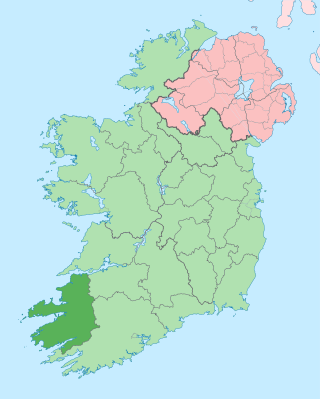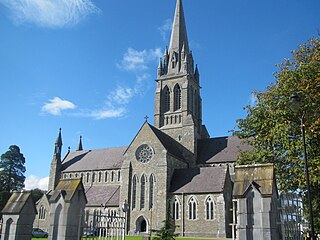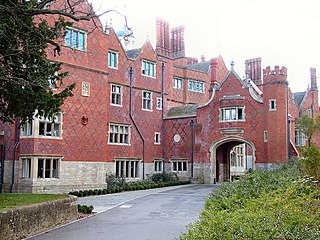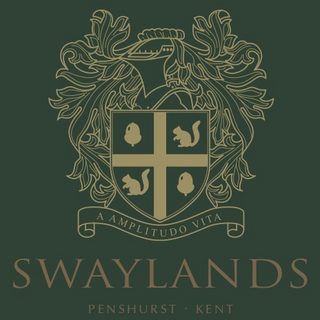


Killarney House is an Irish country home in Killarney, County Kerry, which was built as a replacement for Kenmare House (1726) as the seat of the Earls of Kenmare. The site was chosen by Queen Victoria on her visit to Ireland in 1861.



Killarney House is an Irish country home in Killarney, County Kerry, which was built as a replacement for Kenmare House (1726) as the seat of the Earls of Kenmare. The site was chosen by Queen Victoria on her visit to Ireland in 1861.
It was The 4th Earl of Kenmare who decided to build a new mansion on a hillside with views of Lough Leane in 1872. The old manor, Kenmare House, was demolished and an Elizabethan-Revival manor house on a more elevated site erected at a cost was well over £100,000 (equivalent to £9,499,000in 2021).
This house was supposed to have been instigated by Lady Kenmare (Gertrude Thynne, granddaughter of The 2nd Marquess of Bath) and inspired by Lord Bath's genuinely Elizabethan seat, Longleat, Wiltshire (which is not red-brick); but it was not unusual for the descendants of Elizabethan or Jacobean settlers in Ireland to assert their comparative 'antiquity' in this period by building Jacobethan houses. The architect was George Devey but, according to Jeremy Williams, "... that feeling of being built up over the centuries that distinguished Devey's work was entirely lacking, partly due to the job being supervised by W.H. Lynn [the Belfast architect] at his most relentless ... The westernmost gate lodge, gabled and galleried, [which survives, is] Devey at his most delightful."
The house, in addition to its other defects, apparently did not sit happily in the landscape as it had many gables and many oriels. The interior was panelled and hung with Spanish leather. It was considered one of the finest mansions in Ireland. It was burnt out twice - once in 1879, just after its completion, and again, and finally, in August 1913 and never rebuilt. Instead, The 5th Earl of Kenmare decided to convert the nearby stable block of the old Kenmare House for family use, also naming it "Kenmare House".
In 1956, Mrs Beatrice Grosvenor CBE (1915–1985), niece of the seventh Gerald Ralph Desmond Browne, 7th Earl of Kenmare (1896–1952) and granddaughter of the Duke of Westminster, built Knockreer House on the site of the former "Killarney House". The house was designed by Mrs Grosvenor's cousin Francis Pollen (1926–87). [1] Knockreer House and the surrounding land, formerly part of the Kenmare Estate of the Earls of Kenmare, were later donated by Mrs Grosvenor to form Killarney National Park.[ citation needed ]
Also in 1956, Mrs Grosvenor sold the second "Kenmare House" together with 25,000 acres (100 km2) to an American syndicate, which in turn resold it in 1959 to John McShain (1898–1989), an American building contractor. He and his wife Mary J. Horstmann (1907–1998) extensively renovated the building and renamed it "Killarney House". In 1978, Mr. McShain sold Killarney House and the greater part of the estate to the Irish State for a price well below market value at the time, having been assured that the house and estate would be incorporated into Killarney National Park. Mr and Mrs McShain reserved the house and surrounding 52 acres to their use for their lifetime. Mr McShain died in 1989 and Mrs McShain lived in the house until her death in 1998, when the house and surrounding land reverted to the Irish State. [2] Having been empty for several years, the building fell into some disrepair. In July 2011 Leo Varadkar, then the Irish Minister for Transport, Tourism and Sport, therefore announced a €7 million restoration of the manor. [3] [4] After the completion of the restoration works, Killarney House was opened to the public on 3 April 2016. [5]

County Kerry is a county in Ireland. It is in the Southern Region and the province of Munster. It is named after the Ciarraige who lived in part of the present county. The population of the county was 156,458 at the 2022 census.

Kenmare is a small town in the south of County Kerry, Ireland. The name Kenmare is the anglicised form of Ceann Mara, meaning "head of the sea", referring to the head of Kenmare Bay.
Aodhagán Ó Rathaille or Egan O'Rahilly (c.1670–1726), was an Irish language poet. He is credited with creating the first fully developed Aisling.

Killarney National Park, near the town of Killarney, County Kerry, was the first national park in Ireland, created when the Muckross Estate was donated to the Irish Free State in 1932. The park has since been substantially expanded and encompasses over 102.89 km2 of diverse ecology, including the Lakes of Killarney, oak and yew woodlands of international importance, and mountain peaks. It has the only red deer herd on mainland Ireland and the most extensive covering of native forest remaining in Ireland. The park is of high ecological value because of the quality, diversity, and extensiveness of many of its habitats and the wide variety of species that they accommodate, some of which are rare. The park was designated a UNESCO Biosphere Reserve in 1981. The park forms part of a Special Area of Conservation and a Special Protection Area.

Muckross House is located on the small Muckross Peninsula between Muckross Lake and Lough Leane, two of the lakes of Killarney, 6 kilometres (3.7 mi) from the town of Killarney in County Kerry, Ireland. In 1932 it was presented by William Bowers Bourn and Arthur Rose Vincent to the Irish nation. It thus became the first National Park in the Irish Free State and formed the basis of the present day Killarney National Park. The house now forms part of a visitor attraction marketed as Muckross House, Gardens and Traditional Farms.

Colonel Valentine Augustus Browne, 4th Earl of Kenmare KP, PC, styled Viscount Castlerosse from 1853 to 1871, was a British courtier and Liberal politician. He held office in every Whig or Liberal administration between 1856 and 1886, notably as Lord Chamberlain of the Household under William Gladstone between 1880 and 1885 and in 1886.

Thomas Browne, 6th Baronet & 4th Viscount Kenmare was an Irish landowner and politician.
Detmar Jellings Blow was a British architect of the early 20th century, who designed principally in the arts and crafts style. His clients belonged chiefly to the British aristocracy, and later he became estates manager to the Duke of Westminster.

Adare Manor is a manor house located on the banks of the River Maigue in the village of Adare, County Limerick, Ireland, the former seat of the Earl of Dunraven and Mount-Earl. The present house was built in the early 19th century, though retaining some of the walls of the 17th-century structure. It is now the Adare Manor Hotel & Golf Resort, a luxury hotel, and contains the Michelin-starred Oak Room restaurant.
John McShain was an American building contractor known as "The Man Who Built Washington".

The Diocese of Kerry is a Latin diocese of the Catholic Church in south-western Ireland, one of six suffragan dioceses in the ecclesiastical province of Cashel and Emly.

Goldings Estate is a large Elizabethan style country house and surrounding land close to Waterford, north of Hertford, Hertfordshire, England. The house was designed by George Devey (1820–1886), constructed between 1871 and 1877, and is a Grade II* listed building.

Kenmare House is located on the east shore of Lough Leane and was the principal residence of the Brownes of Killarney, Earls of Kenmare.

Valentine Charles Browne, 5th Earl of Kenmare, styled Viscount Castlerosse from 1871 to 1905, was an Irish peer who served in the Senate of Southern Ireland, and was Lord Lieutenant of Kerry.

Valentine Edward Charles Browne, 6th Earl of Kenmare, styled Viscount Castlerosse from 1905 to 1941, was the Earl of Kenmare and the son of Valentine Browne, 5th Earl of Kenmare.

In British usage, the term townhouse originally referred to the opulent town or city residence of a member of the nobility or gentry, as opposed to their country seat, generally known as a country house or, colloquially, for the larger ones, stately home. The grandest of the London townhouses were stand-alone buildings, but many were terraced buildings.

Swaylands is a private parkland estate set high upon the Kentish Weald, on the edge of the village of Penshurst in the Sevenoaks district of Kent, England.
Mary McShain was an Irish-American landowner and benefactor.

North Great George's Street is a street on the Northside of Dublin city first laid out in 1766 which connects Parnell Street with Great Denmark Street. It consists of opposing terraces of 4-storey over basement red-brick Georgian townhouses descending on an increasingly steep gradient from Belvedere House which bookends the street from a perpendicular aspect to the North.